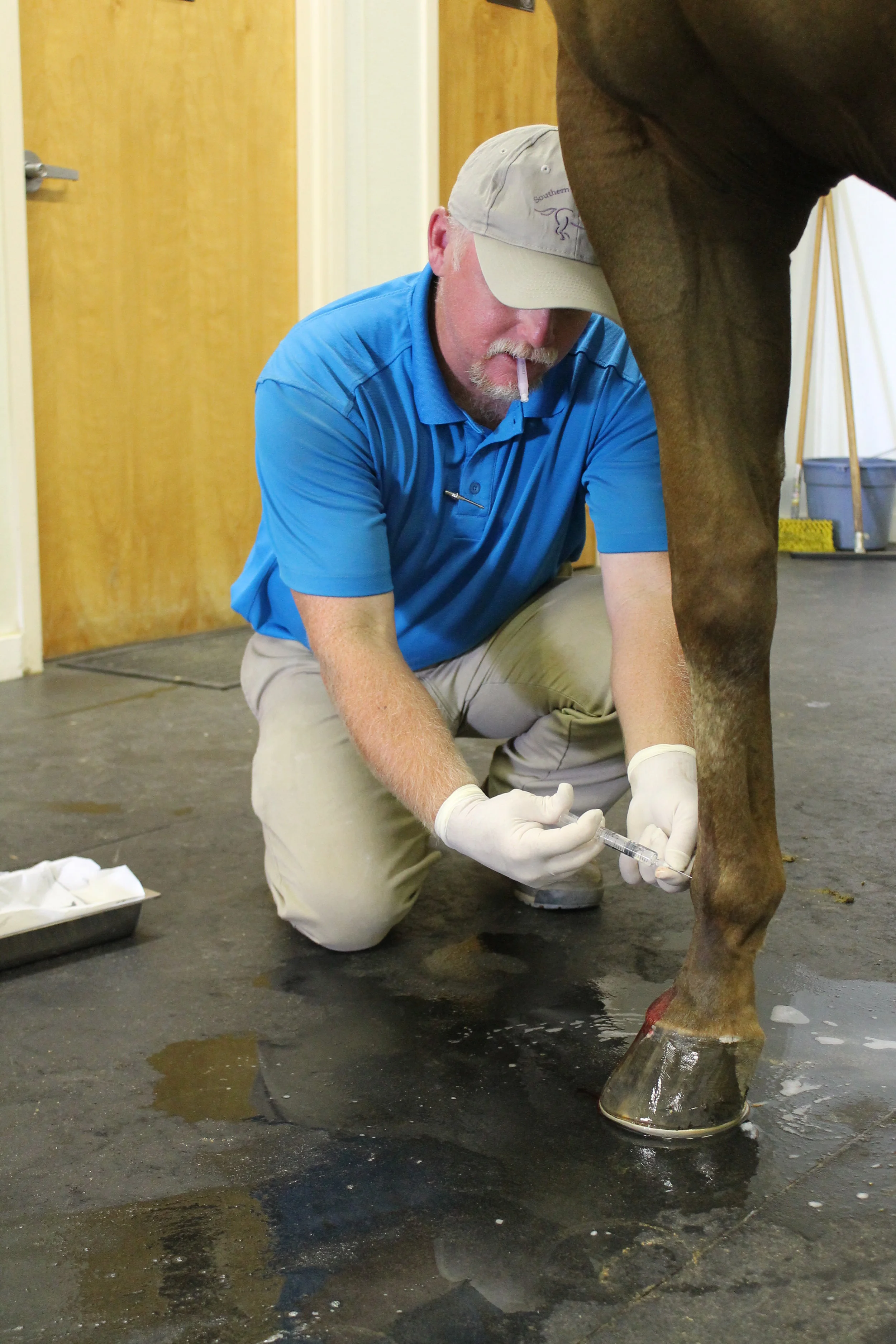SPORTS MEDICINE:
Southern Equine Service provides full lameness exams and cutting edge treatments for our patients. All of our doctors utilize a complete clinical exam to diagnose the cause of lameness. We also use regional anesthesia (blocking) to pinpoint the location of the lameness. We see horses with varying degrees of lameness and base our findings on how the horse presents during the clinical exam. As soon as we pinpoint the location of the lameness we use one of our many diagnostic imaging modalities to determine the cause for the lameness. Once we have a diagnosis, we come up with treatment options and assist the owner in making the best treatment decision for his/her situation and horse.
+ Performance/Lameness Exam
Lameness in horses is a serious and painful problem with several possible causes, and it is important to notice the signs early to improve the chances of successful treatment. Lameness is a problem if your horse‘s gait is abnormal in any way.
This examination uses staticand dynamic evaluations to determine if the horse is showing signs of pain associated with the musculoskeletal system.
Flexion tests are used to localize lameness, but temporarily focusing stress on a specific joint or set of joints to observe the change in gait at the walk or trot. If lameness is detected, diagnostic nerve blocks can be used to localize the source of the pain. Once pain is localized, diagnostic imaging including radiographs (x-rays) or ultrasound can be used to evaluate the soft tissue and boney structures in that area to determine the source of the lameness. Some lameness cases require advanced diagnostic imaging such as bone scan or MRI. If no obvious lameness occurs, we offer the option of chiropractic and acupuncture services to restore the range of motion as well as relieve muscle pain.
+ Regenerative Medicine
IRAP(Interleukin-1 Receptor Antagonist Protein): IRAP is ACS(autologous-conditioned serum) and is harvested from the horse's own blood. IRAP is used to treat osteoarthritis and other inflammatory conditions in the joint. IL-1 (interleukin 1) is a cytokine and an inflammatory mediator that binds to the membrane on cartilage in joints leading to inflammation, joint pain, and cartilage destruction. IL-1Ra (interleukin-1 receptor antagonist protein) attaches to the receptor on the cartilage membrane blocking IL-1 from binding and causing inflammation in the joint. IRAP takes the horse's own blood and processes it in a way that the amount of IL-1Ra is amplified in the serum. The serum is frozen and can be injected into the horse's joint at any time.
PRP (Platelet Rich Plasma): PRP is derived from the horse's own blood. It is a solution of concentrated platelets which release growth factors that accelerate regeneration of injured tissues by enhancing fibroblastic events involved in tissue healing. PRP can be injected into joints, tendons and ligaments.
Pro-Stride: Pro-Stride is a drug free, steroid free way to treat joint pain and disease. It is a dual-device system that combines a concentrated solution of cells, platelets, growth factors, and anti-inflammatory proteins. These healing factors come from a simple blood draw from the horse. Click here for an informative video on how it works and how it could benefit your equine athlete.
A2M (Alpha2EQ): A2M isolates the Alpha-2 macroglobulin from horse's own blood. This potent biological anti-inflammatory molecule addresses lameness incluidng joint and soft tissue injury, as well as upper airway inflammation. This multi-dose kit can be frozen forup to 12 months. A2M is available for on site processing.
Extracorporeal Shockwave therapy (PulseVet): Shockwaves are high energy acoustic waves with high amplitude. Shockwave increases blood supply to affected areas and promotes linear pattern of healing in tendons and ligaments. It also decreases pain via incomplete analgesia. We find it most effective when we combine shockwave therapy with other treatments such as PRP. Common injuries treated successfully with extracorporeal shockwave: tendonitis, muscle strains, chronic wounds, ringbone, suspensory desmitis, kissing spine, navicular pain, and tendon avulsions. Our shockwave therapy usually consists of 3 treatments 2 weeks apart.
RLT Regenerative Laser: Even the best equine veterinarian is limited on healing of serious tendon and ligament injuries to our equine athletes. What if we could regenerate the tissue? Re-align the fibers? Strengthen the very core of the problem? WE CAN. Regenerative laser therapy has allowed us to keep our head above water when it comes to rehabbing tendon and ligament injuries.
+ Pre-Purchase Exam
SES offers pre-purchase examinations for prospective buyers. The pre-purchase examination includes a full physical exam, soundness exam, Coggins test, health certificate and optional drug screening. We offer radiograph packages and are happy to do any other diagnostics such as endoscopy or blood work at additional charges. If the prospective buyer cannot be present for the exam, we always communicate with him/her to discuss any findings and how he/she would like to proceed. We can email radiographs taken during the pre-purchase exam for the prospective buyer. We provide a written report of all findings from the exam for the buyer. Prepurchase exams can be performed on the farm on in the clinic. If you'd like to request a PPE or begin the required paperwork, please see our Client Portal.


